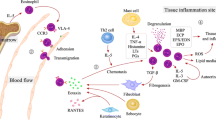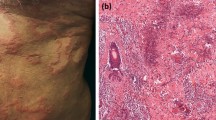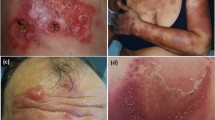Abstract
The hypereosinophilic syndromes (HES) are a heterogeneous group of disorders defined as persistent and marked blood eosinophilia of unknown origin with systemic organ involvement. HES is a potentially severe multisystem disease associated with considerable morbidity. Skin involvement and cutaneous findings frequently can be seen in those patients. Skin symptoms consist of angioedema; unusual urticarial lesions; and eczematous, therapy-resistant, pruriginous papules and nodules. They may be the only obvious clinical symptoms. Cutaneous features can give an important hint to the diagnosis of this rare and often severe illness. Based on advances in molecular and genetic diagnostic techniques and on increasing experience with characteristic clinical features and prognostic markers, therapy has changed radically. Current therapies include corticosteroids, hydroxyurea, interferon-α, the tyrosine kinase inhibitor imatinib mesylate, and (in progress) the monoclonal anti–interleukin-5 antibodies. This article provides an overview of current concepts of disease classification, different skin findings, and therapy for HES.







Similar content being viewed by others
References
Griffin H. Persistant eosinophilia with hyperleucocytosis and splenomegaly. Am J Med Sci. 1919;158:618–29.
Hardy WR, Anderson R. The hypereosinophilic syndrome. Ann Intern Med Sci. 1968;158:618–29.
Weller PF. Eosinophils: structure and functions. Curr Opin Immunol. 1994;6:85–91.
Weller PF, Bubley GJ. The idiopathic hypereosinophilic syndrome. Blood. 1994;83:2759–79.
Spry CJ. The hypereosinophilic syndrome: clinical features, laboratory findings and treatment. Allergy. 1982;37(8):539–51.
Weller PF, Dvorak AM. The idiopathic hypereosinophilic syndrome. Arch Dermatol. 1996;132:583–5.
Gleich GJ, Schroeter AL, Marcoux P, et al. Episodic angioedema associated with eosinophilia. N Engl J Med. 1984;310:1621–6.
Sheikh J, Weller PF. Clinical overview of hypereosinophilic syndromes. Immunol Allergy Clin North Am. 2007;27(3):333–55.
Chusid MJ, Dale CD, West BC. The hypereosinophilic syndrome: analysis of 14 cases with review of the literature. Medicine. 1975;54:1–27.
Sheikh J, Weller PF. Advances in diagnosis &treatment of eosinophilia. Curr Opin Hematol. 2009;16(1):3–8.
Schwartz LB, Sheikh J, Singh A. Current strategies in the management of hypereosinophilic syndrome, including mepolizumab. Curr Med Res Opin. 2010;26(8):1933–46.
Simon HU, Rothenberg ME, Bochner BS, Weller PF, Wardlaw AJ, Wechsler ME, Rosenwasser LJ, Roufosse F, Gleich GJ, Klion AD. Refining the definition of hypereosinophilic syndrome. JACI. 2010;126(1):45–9.
Roufosse F, Goldman M, Cogan E. Hypereosinophilic syndrome: lymphoproliferative and myeloproliferative variants. Semin Respir Crit Care Med. 2006;27:158–70.
Ring J. Allergy in practice. New York: Springer Berlin; 2005.
Ring J, Ruzicka T, Przybilla B, editors. Handbook of atopic eczema. 2nd ed. New York: Springer Berlin; 2006.
Roufosse F, Cogan E, Goldman M. The hypereosinophilic syndrome revisited. Annu Rev Med. 2003;54:169–84.
Roufosse F, Cogan E, Goldman M. Recent advances in the pathogenesis and management of hypereosinophilic syndromes. Allergy. 2004;59:673–89.
Roufosse F, Cogan E, Goldman M. Lymphocytic variant of hypereosinophilic syndromes. Immunol Allergy Clin North Am. 2007;27(3):389–413.
Simon HU, Plötz SG, Dummer R, Blaser K. Abnormal clones of T cells producing interleukin-5 in idiopathic eosinophilia. N Engl J Med. 1999;341(15):1112–20.
Plötz SG, Simon HU, Darsow U, et al. Use of an anti-interleukin-5 antibody in the hypereosinophilic syndrome with eosinophilic dermatitis. N Engl J Med. 2003;349(24):2334–9.
Cools J, De Angelo D, Gotlib J, et al. A tyrosine kinase created by fusion of the PDGRA and FIP1L1 genes as therapeutic target of imatinib in idiopathic hypereosinophilic syndrome. N Engl J Med. 2003;348(13):1201–14.
Klion AD, Noel P, Akin C, et al. Elevated serum tryptase levels identify a subset of patients with a myeloproliferative variant of idiopathic hypereosinophilic syndrome associated with tissue fibrosis, poor prognosis, and imatinib responsiveness. Blood. 2003;101(12):4660–6.
Klion AD, Bochner BS, Gleich GJ, et al. The Hypereosinophilic Syndromes Working Group. Approaches to the treatment of hypereosinophilic syndromes: a workshop summary report. J Allergy Clin Immunol. 2006;117(6):1292–302.
Reiter A, Grimwade D, Cross NC. Diagnostic and therapeutic management of eosinophilia-associated chronic myeloproliferative disorders. Haematologica. 2007;92(9):1153–8.
Reiter A, Inverbizzi R, Cross NC, Cazzola M. Molecular basis of myelodysplastic/myeloproliferative neoplasms. Haematologica. 2009;94(12):1634–8.
Gleich GF, Leifermann KM, Pardanani A, et al. Treatment of hypereosinophilic syndrome with imatinib mesilate. Lancet. 2002;359:1577–8.
Valent P. Pathogenesis, classification and therapy of eosinophilia and eosinophilic disorders. Blood Rev Med. 2003;23:157–65.
Bain BJ. Relationship between idiopathic hypereosinophilic syndrome, eosinophilic leukaemia, and systemic mastocytosis. Am J Hematol. 2004;77(1):82–5.
Leiferman KM, Gleich GJ. Hypereosinophilic syndrome: case presentation and update. J Allergy Clin Immunol. 2004;113(1):50–8.
Leiferman KM, O’Duffy JD, Perry HO, et al. Recurrent incapacitating mucosal ulcerations. A prodrome of the hypereosinophilic syndrome. JAMA. 1982;247(7):1018–20.
Leiferman KM, Gleich GJ, Peters MS. Dermatologic manifestations of the hypereosinophilic syndromes. Immunol Allergy Clin North Am. 2007;27(3):415–41.
Rothenberg ME, Klion AD, Roufosse FE, et al. Treatment of patients with the hypereosinophilic syndrome with mepolizumab. N Engl J Med. 2008;358:1215–28.
Sanderson CJ. Pharmacological implications of interleukin-5 in the control of eosinophilia. Adv Pharmacol. 1992;23:163–77.
Sanderson CJ. Interleukin-5, eosinophils, and disease. Blood. 1992;79(12):3101–9.
Cogan E, Schandene L, Crusiaux A, et al. Brief report: clonal proliferation of type 2 helper T cells in a man with the hypereosinophilic syndrome. N Engl J Med. 1994;330:535–8.
Simon HU, Yousefi S, Dommann-Scherrer C, et al. Expansion of cytokine-producing CD4-CD8- T cells associated with abnormal Fas expression and hypereosinophilia. J Exp Med. 1996;183:1071–82.
Roufosse F, Schadene L, Sibille C, et al. Clonal Th2 lymphocytes in patients with the idiopathic hypereosinophilic syndrome. Br J Hematol. 2000;109:540–8.
Helbig G, Wieczorkiewicz A, Dziaczkowska-Suszek J, et al. T-cell abnormalities are present at high frequencies in patients with hypereosinophilic syndrome. Haematologica. 2009;94:1236–41.
Plötz SG, Dibbert B, Abeck D, et al. Bcl-2 expression by eosinophils in a patient with hypereosinophilia. J Allergy Clin Immunol. 1998;102:1037–40.
Roufosse F. Hypereosinophilic syndrome variants: diagnostic and therapeutic considerations. Haematologica. 2009;94:1188–93.
Spry CJ, Kay AB, Gleich GJ. Eosinophils. Immunol Today. 1992;13:384–7.
Plotz SG, Abeck D, Seitzer U, Hein R, Ring J. UVA1 for hypereosinophilic syndrome. Acta Derm Venereol. 2000;80:221.
De Lavareille A, Roufosse F, Schmid-Grendelmeier P, et al. High serum thymus and activation-regulated chemokine levels in the lymphocytic variant of the hypereosinophilic syndrome. J Allergy Clin Immunol. 2002;110:476–9.
Simon HU, Plotz SG, Simon D, et al. Clinical and immunological features of patients with interleukin-5-producing T cell clones and eosinophilia. Int Arch Allergy Immunol. 2001;124(1–3):242–5.
O’Shea JJ, Jaffe ES, Lane HC, et al. Peripheral T cell lymphoma presenting as hypereosinophilia with vasculitis. Clinical, pathologic, and immunologic features. Am J Med. 1987;82(3):539–45.
Moraillon I, Bagot M, Bourneriaas I, et al. Hypereosinophilic syndrome with pachyderma preceding lymphoma. Treatment with interferon alpha. Acta Derm Venereol. 1991;118(11):883–5.
Kim CJ, Park SH, Chi JG. Idiopathic hypereosinophilic syndrome terminating as disseminated T-cell lymphoma. Cancer. 1991;67(4):1064–9.
Simon D, Simon HU. Eosinophilic disorders. J Allergy Clin Immunol. 2007;119:1291–300.
Fauci AS, Harley JB, Roberts WC, et al. The idiopathic hypereosinophilic syndrome. Clinical, pathophysiologic and therapeutic considerations. Ann Intern Med. 1982;97(1):78–91.
Parillo JE, Fauci AS, Wolff SM. Therapy of the hypereosinophilic syndrome. Ann Intern Med. 1978;89:167–72.
Kazmierowski JA, Chusid MJ, Parillo JE, et al. Dermatologic manifestations of the hypereosinophilic syndrome. Arch Dermatol. 1978;114:531–5.
Shelley WB, Shelley ED. Erythema annulare centrifugum as the presenting sign of the hypereosinophilic syndrome. Cutis. 1985;35:53–8.
Milijkovic J, Bartenev I. Hypereosinophilic dermatitis-like erythema annulare centrifugum in a patient with chronic lymphocytic leukaemia. J Eur Acad Dermatol Venereol. 2005;19(2):228–31.
Ohtani T, Okamoto K, Kaminaka C, et al. Digital gangrene associated with idiopathic hypereosinophilia: treatment with allogeneic cultured dermal substitute (CDS). Eur J Dermatol. 2004;14(3):168–71.
Jang KA, Lim YS, Cchoi JH, et al. Hypereosinophilic syndrome presenting as cutaneous necrotizing eosinophilic vasculitis and Raynaud’s phenomenon complicated by digital gangrene. Br J Dermatol. 2000;143(3):641–4.
Bogenrieder T, Griese DP, Schiffner R, et al. Well’s syndrome as a manifestation of hypereosinophilic syndrome. Br J Dermatol. 1997;137(6):978–82.
Tsuji Y, Kawashima T, Yokota K, et al. Well’s syndrome as a manifestation of hypereosinophilic syndrome. Br J Dermatol. 2002;147(4):811–2.
Plötz SG, Abeck D, Behrendt H, et al. Eosinophilic cellulitis (Wells syndrome). Hautarzt. 2000;51(3):182–6.
Butterfield JH, Leifermann KM, Abrams J, et al. Elevated serum levels of interleukin-5 in patients with the syndrome of episodic angioedema and eosinophilia. Blood. 1992;79:688–92.
Banerji A, Weller PF, Sheikh J. Cytokine-associated angioedema syndromes including episodic angioedema with eosinophilia (Gleich’s syndrome). Immunol Allergy Clin North Am. 2006;26(4):769–81.
Leiferman KM, Loegering DA, Gleich GJ. Production of wheal-and-flare skin reactions by eosinophil granule proteins. J Invest Dermatol. 1984;82:414.
Leiferman KM, Peter MS. Eosinophils in cutaneous diseases. In: Wolff K, Goldsmith LA, Katz SI, Gilchrest B, Paller AS, Leffel DJ, editors. Fitzpatrick’s dermatology in general medicine, 7th ed, Chap 35. New York Chicago: McGraw-Hill, Inc.; 2008.
Jacyk WK, Simson LW, Slater DN, Leiferman KM. Pachydermatous eosinophilic dermatitis. Br J Dermatol. 1996;134:474–4698.
Plötz SG, Simon HU, Ring J. Hautmanifestationen bei Hypereosinophiliesyndrom. Allergologie. 1998;21:489–98.
Plötz SG, Abeck D, Hein R, Ring J. High-dose UVA1 for hypereosinophilic syndrome. Arch Dermatol Res. 1998;290:81.
Butterfield JH, Gleich GJ. Interferon alpha treatment of six patients with the idiopathic hypereosinophilic syndromes. Ann Intern Med. 1994;121(9):648–53.
Hendren WG, Jones EL, Smith MD. Aortic and mitral valve replacement in idiopathic hypereosinophilic syndrome. Ann Thorac Surg. 1988;46(5):570–1.
Vandenberghe P, Wlodarska I, Michaux L, et al. Clinical and molecular features of FIP1L1-PDFGRA (+) chronic eosinophilic leukemias. Leukemia. 2004;18(4):734–42.
Rotoli B, Catalano L, Galderisi M, et al. Rapid reversion of Loeffler’s endocarditis by imatinib in early stage clonal hypereosinophilic syndrome. Leuk Lymphoma. 2004;45(12):2503–7.
Moore PM, Harley JB, Fauci AS. Neurologic dysfunction in the idiopathic hypereosinophilic syndrome. Ann Intern Med. 1985;102(1):109–14.
Monaco S, Lucci B, Laperchia N, et al. Polyneuropathy in hypereosinophilic syndrome. Neurology. 1988;38(3):494–6.
Lefebvre C, Bletry O, Degoulet P, et al. Facteurs pronostiques du syndrome hypereosinophilique. Etude de 40 observations. Ann Med Interne (Paris). 1989;140:253–7.
Cordier JF, Faure M, Hermier C, Brune J. Pleural effusions in an overlap syndrome of idiopathic hypereosinophilic syndrome and erythema elevatum diutinum. Eur Respir J. 1990;3(1):115–8.
Levesque H, Elie-Legrand MC, Thorel JM, et al. Idiopathic hypereosinophilic syndrome with predominant digestive manifestations or eosinophilic gastroenteritis? a propos of 2 cases. Gastroenterol Clin Biol. 1990;14(6–7):586–8.
Scheurlen M, Mork H, Weber P. Hypereosinophilic syndrome resembling chronic inflammatory bowel disease with primary sclerosing cholangitis. J Clin Gastroenterol. 1992;14(1):59–63.
Croffy B, Kopelman R, Kaplan M. Hypereosinophilic syndrome. Association with chronic active hepatitis. Dig Dis Sci. 1988;33(2):233–9.
Elouaer-Blanc L, Zafrani ES, Farcet JP, et al. Hepatic vein obstruction in idiopathic hypereosinophilic syndrome. Arch Intern Med. 1985;145(4):751–3.
Eugene C, Gury B, Bergue A, Quevauvilliers J. Icterus disclosing pancreatic involvement in idiopathic hypereosinophilic syndrome. Gastroenterol Clin Biol. 1984;8(12):966–9.
Chaine G, Davies J, Kohner EM, et al. Ophthalmologic abnormalities in the hypereosinophilic syndrome. Opthalmology. 1982;89(12):1348–56.
Binaghi M, Perrenoud F, Dhermy P, et al. Hypereosinophilic syndrome with ocular involvement. J Fr Opthalmol. 1985;8(4):309–14.
Takekawa M, Imai K, Adachi M, et al. Hypereosinophilic syndrome accompanied with necrosis of finger tips. Intern Med. 1992;31:1262–6.
Trueb RM, Lubbe J, Torricelli R, et al. Eosinophilic myositis with eosinophilic cellulitis like skin lesions. Association with increased serum levels of eosinophil cationic proteins and interleukin-5. Arch Dermatol. 1997;133:203–6.
Trueb RM, Pericin M, Winzeler B, et al. Eosinophilic myositis/perimyositis: frequence and spectrum of cutaneous manifestations. J Am Acad Dermatol. 1997;37:385–91.
Schooley RT, Flaum MA, Gralnick HR, Fauci AS. A clinicopathologic correlation of the idiopathic hypereosinophilic syndrome II: clinical manifestations. Blood. 1991;58:1021–6.
Flaum MA, Schooley RT, Fauce AS, Gralnick HR. A clinicopathologic correlation of the idiopathic hypereosinophilic syndrome. Blood. 1981;58(5):1012–20.
Brugnoni D, Airo P, Rossi G, et al. A case of hypereosinophilic syndrome is associated with the expansion of a CD3− CD4+ T-cell population able to secrete large amounts of Interleukin-5. Blood. 1996;87:1416–22.
Busse WW, Ring J, Huss-Marp J, Kahn E. A review of treatment with mepolizumab, an anti-IL-5 mAb, in hypereosinophilic syndromes and asthma. JACI. 2010;125(4):803–13.
Jovanovic JV, Score J, Waghorn K, et al. Low-dose imatinib mesylate leads to rapid induction of major molecular responses and achievement of complete molecular remission in FIP1L1-PDGFRA-positive chronic eosinophilic leukemia. Blood. 2007;109(11):4635–40.
Ogbogu PU, Bochner BS, Butterfield JH, et al. Hypereosinophilic syndromes: a multicenter, retrospective analysis of clinical characteristics and response to therapy. J Allergy Clin Immunol. 2009;124:1319–25.
Chikama R, Hosokawa M, Miyazawa T, et al. Nonepisodic angioedema associated with eosinophilia. Report of 4 cases and review of 33 young female patients reported in Japan. Dermatology. 1998;197:321–5.
Spigel T, Winkelmann RK. Wells’ syndrome. Arch Dermatol. 1979;115:611–3.
Kamani N, Lipsitz PJ. Eosinophilic cellulitis in a family. Pediatr Dermatol. 1987;4:220–4.
Peters MS, Schroeter AL, Gleich GJ. Immunofluorescence identification of eosinophil granule major basic protein in the flame figures of Wells’ syndrome. Br J Dermatol. 1983;109:141–8.
Yagi H, Tokura Y, Matsushita K, et al. Well’s syndrome: a pathogenetic role for circulating CD4 + CD7− T-cells expressing Interleukin-5 mRNA. Br J Dermatol. 1997;136:918–23.
Nir MA, Westfried M. Hypereosinophilic dermatitis. A distinct manifestation of the hypereosinopilie syndrome with response to dapsone. Dermatology. 1981;162:444–50.
Schmelas A, Drobnitsch I, Schneider I. Hypereosinophilic dermatitis with response to ketotifen and sulfone. Dermatol Monatsschr. 1986;172(7):397–402.
Butterfield JH, Leifermann KM, Gleich GJ. Nodules, eosinophilia, rheumatism, dermatitis and swelling (NERDS): a novel eosinophilic disorder. Clin Exp Allergy. 1993;23:571–80.
Pardanani A, Brockman SF, Paternoster SF, et al. FIP1L1-PDGFRA fusion: prevalence and clinicopathologic correlates in 89 consecutive patients with moderate to severe eosinophilia. Blood. 2004;104(10):3038–45.
Kimura T, Yoshimura S, Ishikawa E. Unusual granulation combined with hyperplastic changes in lymphatic tissue. Trans Jpn Soc Pathol. 1948;13:179–80.
Kung IT, Gibson JB, Bannatyne PM. Kimura’s disease: a clinicopathological study of 21 cases and its distinction from angiolymphoid hyperplasia with eosinophilia. Pathology. 1984;16(1):39–44.
Wang TF, Liu SH, Kao CH, et al. Kimura’s disease with generalized lymphadenopathy demonstrated by positron emission topography scan. Intern Med. 2006;45(12):775–8.
Chun SI. Kimura’s disease and ALHE with eosinophilia. J Am Acad Dermatol. 1992;27:954.
Conelly A, Powell HR, Chan YF, et al. Vincristine treatment of nephrotic syndrome complicated by Kimura’s disease. Pediatr Nephrol. 2005;20(4):516–8.
Braun-Falco M, Fischer S, Plotz SG, Ring J. Angiolymphoid hyperplasia with eosinophilia treated with anti-interleukin-5 antibody (mepolizumab). Br J Dermatol. 2004;151(5):1103–4.
Klion AD. Approach to the therapy of hypereosinophilic syndromes. Immunol Allergy Clin North Am. 2007;27:551–60.
Simon HU, Cools J. Novel approaches to therapy of hypereosinophilic syndromes. Immunol Allergy Clin North Am. 2007;27:519–27.
Klion AD, How I. treat hypereosinophilic syndromes. Blood. 2009;114:3736–41.
Gleich GJ, Leifermann KM. The hypereosinophilic syndromes: current concepts and treatments. Br J Hematol. 2009;145:271–85.
Van den Hoogenband HM, van den Berg WH, van Diggelson MW. PUVA-therapy in the treatment of skin lesions of the hypereosinophilic syndrome. Clin Exp Dermatol. 1985;7:267–72.
Eberlein A, von Kobyletzki G, Gruss C, et al. Erfolgreiche Monotherapie der hypreosinophilen Dermatitis mit PUVA-Bad-Photochemotherapie. Hautarzt. 1997;11:820–43.
Smit AJ, van Essen LH, de Vries EG. Successful long-term control of idiopathic hypereosinophilic syndrome with etoposide. Cancer. 1991;67:2826–7.
Zielinski RM, Lawrence WD. Interferon alpha for the hypereosinophilic syndrome. Ann Intern Med. 1990;113:716–8.
Sefcick A, Sowter D, Da Gupta E, et al. Alemtuzumab therapy for refractory idiopathic hypereosinophilic syndrome. Br J Haematol. 2004;124:558–9.
Verstovsek S, Tefferi A, Kantarjian H, et al. Alemtuzumab therapy for hypereosinophilic syndrome and chronic eosinophilic leukemia. Clin Cancer Res. 2009;15(1):268–73.
Simon D, Braathen LR, Simon HU. Anti-interleukin-5 therapy for eosinophilic diseases. Hautarzt. 2007;122:124–7.
Leckie MF, ten Brinke A, Khan J, et al. Effects of recombinant human interleukin-12 on eosinophils, airway hyper-responsiveness, and the late asthmatic response. Lancet. 2000;356:2149–53.
Oldhoff JM, Darsow U, Werfel T, et al. Anti-IL-5 recombinant humanized monoclonal antibody (mepolizumab) for the treatment of atopic dermatitis. Allergy. 2005;60:693–6.
Kay AB, Klion AD. Anti-interleukin-5 therapy for asthma and hypereosinophilic syndrome. Immunol Allergy Clin North Am. 2004;114:1449–55.
Klion AD, Robyn J, Maric I, et al. Relapse following discontinuation of imatinib mesylate therapy for FIP1L1/PDGFRA-positive chronic eosinophilic leukaemia: implications for optimal dosing. Blood. 2007;110:3552–6.
Disclosure
No potential conflicts of interest relevant to this article were reported.
Author information
Authors and Affiliations
Corresponding author
Rights and permissions
About this article
Cite this article
Plötz, S.G., Hüttig, B., Aigner, B. et al. Clinical Overview of Cutaneous Features in Hypereosinophilic Syndrome. Curr Allergy Asthma Rep 12, 85–98 (2012). https://doi.org/10.1007/s11882-012-0241-z
Published:
Issue Date:
DOI: https://doi.org/10.1007/s11882-012-0241-z




